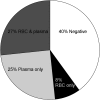Viable bacteria associated with red blood cells and plasma in freshly drawn blood donations
- PMID: 25751254
- PMCID: PMC4353618
- DOI: 10.1371/journal.pone.0120826
Viable bacteria associated with red blood cells and plasma in freshly drawn blood donations
Abstract
Objectives: Infection remains a leading cause of post-transfusion mortality and morbidity. Bacterial contamination is, however, detected in less than 0.1% of blood units tested. The aim of the study was to identify viable bacteria in standard blood-pack units, with particular focus on bacteria from the oral cavity, and to determine the distribution of bacteria revealed in plasma and in the red blood cell (RBC)-fraction.
Design: Cross-sectional study. Blood were separated into plasma and RBC-suspensions, which were incubated anaerobically or aerobically for 7 days on trypticase soy blood agar (TSA) or blue lactose plates. For identification colony PCR was performed using primers targeting 16S rDNA.
Setting: Blood donors attending Capital Region Blood Bank, Copenhagen University Hospital, Rigshospitalet, Hvidovre, Denmark, October 29th to December 10th 2013.
Participants: 60 donors (≥50 years old), self-reported medically healthy.
Results: Bacterial growth was observed on plates inoculated with plasma or RBCs from 62% of the blood donations. Growth was evident in 21 (35%) of 60 RBC-fractions and in 32 (53%) of 60 plasma-fractions versus 8 of 60 negative controls (p = 0.005 and p = 2.6x10-6, respectively). Propionibacterium acnes was found in 23% of the donations, and Staphylococcus epidermidis in 38%. The majority of bacteria identified in the present study were either facultative anaerobic (59.5%) or anaerobic (27.8%) species, which are not likely to be detected during current routine screening.
Conclusions: Viable bacteria are present in blood from donors self-reported as medically healthy, indicating that conventional test systems employed by blood banks insufficiently detect bacteria in plasma. Further investigation is needed to determine whether routine testing for anaerobic bacteria and testing of RBC-fractions for adherent bacteria should be recommended.
Conflict of interest statement
Figures

References
-
- Perez P, Salmi LR, Follea G, Schmit JL, et al., and the French Haemovigilance Network. Determinants of transfusion-associated bacterial contamination: results of the French BACTHEM Case-Control Study. Transfusion. 2001;41: 862–872. - PubMed
-
- Kuehnert MJ, Roth VR, Haley NR, et al. (2000) Transfusion-transmitted bacterial infection in the United States, 1998 through 2000. Transfusion. 2000;41: 1493–9. - PubMed
Publication types
MeSH terms
LinkOut - more resources
Full Text Sources
Other Literature Sources
Research Materials

